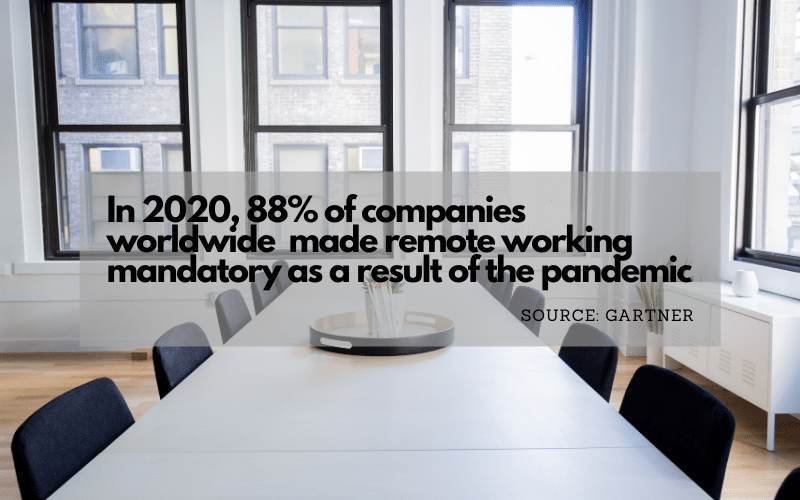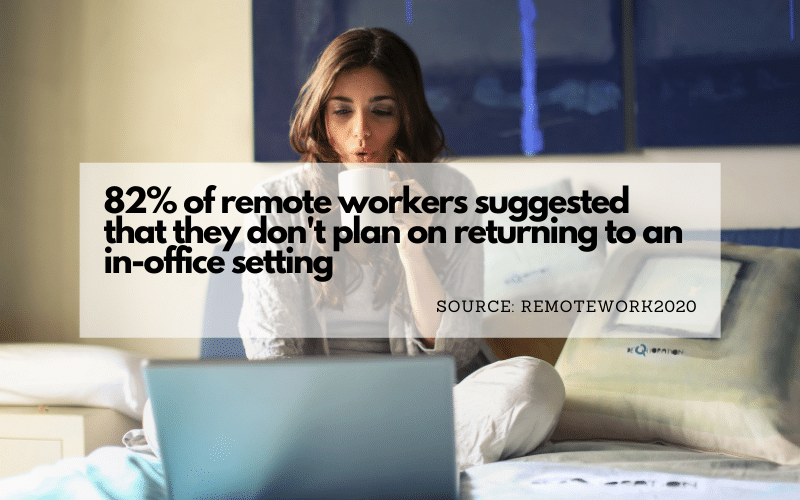Remember the old saying “there’s no I in team”? It might be one of those things your teacher used to tell you in school when you were getting overly-competitive, but it’s true, nevertheless.
Teamwork is an essential aspect of business success, and it’s a concept that’s constantly evolving in response to digitalization and the remote work revolution.
Businesses are waking up to the benefits of remote work, and fostering a strong virtual collaboration environment is more important than ever before. Organisations need to implement strong team collaboration strategies that are flexible, effective, and sustainable.
Photo by Anton Shuvalov on Unsplash
In this article, we’ll look at the advantages of collaboration in business, and why it’s just as important for remote teams to learn effective team collaboration practices. We’ll outline some of the pitfalls of remote work, and suggest some best practices and tools succeed in remote workforce collaboration. All to help you achieve your business goals.
Benefits of Collaboration in Business
If there’s one standout factor that contributes to business success, it’s team collaboration. In fact, according to a study by the Queen’s University of Charlotte, 75% of employees regard teamwork and collaboration as important. So the question remains, why is collaborating effectively so important?
The general goal of the collaboration is to maximise the success of a business. When teams work together seamlessly they have more impact than a single individual would. Teamwork collaboration in business involves leveraging each individual’s strengths to meet business goals and drive results. A collaborative workplace is a case study in teamwork making the dream work.
Working collaboratively enables team members to share information, build healthy workplace relationships, and work more effectively. It allows collaborators to work together towards a defined business goal, increasing the chances of success through a collaborative effort.
Effective collaboration results in:
- Improved productivity levels
- Optimised workflow processes
- Healthier team relationships and happier employees
- Increased efficiency
Photo by Brooke Cagle on Unsplash
So what are the concrete benefits of remote collaboration and how does it maximise business success? Here are just a few:
- Promotes problem-solving: collaboration allows teams to bring together diverse skill sets, which provides more scope for knowledge sharing and solving problems creatively and efficiently while making sure any blind-spots are covered.
- Learning and sharing skills: it allows team members to work across departments, learn from one another, and share their know-how with feedback and viewpoints.
- Increases employee satisfaction: greater connectivity in business results in higher satisfaction rates among employees. Teams are happier, and there is better workplace culture. When employees feel heard and valued by their team members, they’re more likely to want to come to work and to enjoy their job.
- Goal alignment: Collaboration enables teams to see the “big picture” by combining various skill sets and aligning their goals to the same business objectives.

State of Remote Work
In today’s cloud-based digital environment, there are endless opportunities for remote work that provide employees with greater flexibility. However, it’s not just about working in your PJs or answering emails from a beach in Bali. Remote work is reshaping and revolutionising the concept of “work” as we know it.
Now more than ever, organisations across industries – from healthcare to manufacturing – are leveraging the benefits of remote work for employees, businesses, and customers. For employees, this means increased flexibility; for 85% of businesses, it means improved employee productivity; and for customers, it means improved customer experience.
The state of remote work in 2020 has shifted dramatically. 88% of companies worldwide made remote work mandatory during the year. Employees who previously had no experience working remotely, set up their work-from-home office, and found ways to remain productive.

Putting strategies in place for successful remote working practices is crucial for business success and employee retention in a world where remote work has become and will continue to be, the norm. As a result, organisations must formalise structures for remote working functionality that mitigate the major hurdles it poses to successful teamwork.
Challenges such as outdated technology, remote project management, and a lack of in-person interactions must be faced head-on in order for businesses to function and continue to meet business objectives.
According to a survey, respondents (remote work employees) reported that some of the benefits of working remotely included:
- Schedule flexibility (32%)
- Location flexibility (26%)
- No commute time (21%)
- More family time (11%)
While there are plenty of advantages to working remotely, it’s not without its disadvantages. In the same survey, respondents said that some of the struggles they face associated with remote work included:
- Collaboration and communication (20%)
- Loneliness (20%)
- Difficulty separating work time and personal time (18%)
- Distractions (12%)
The global shift towards remote work shows no sign of slowing down in the future. The advantages seem to outweigh the disadvantages of remote work for employees, with 82% of remote workers reporting that they don’t plan on returning to an in-office work environment.
Remote work also puts companies at a hiring advantage, with 62% of survey respondents claiming that they’d consider leaving a co-located company to secure a remote role.

Remote Collaboration Pitfalls
Despite the numerous benefits that a work-from-home lifestyle provides, there are also some key areas where employees consistently report pitfalls in successful remote collaboration. Let’s take a look at some of the most common challenges that remote workers face.
1. Ineffective team communication.
Say you’re part of a remote team that’s spread over the country or even the globe. It can be challenging for such teams to get used to new methods of asynchronous communication. The results are often miscommunications, mistakes, and wasted time.
It’s easy to take for granted the instant communication that an office space facilitates. Without a great communication tool, effective communication between remote workers is extremely difficult. Working remotely requires teams to adapt to a transition from instant to asynchronous communication methods, and to reconsider their expectations around quick response times.
2. Lack of workplace culture.
Building relationships and trust among employees is obviously much easier in person, especially when there are Friday after-work drinks involved. Lack of workplace culture results in employees feeling isolated and distanced from their team, or people in general.
Fostering an open and honest environment is just as important to remote work teams and their success. Culture plays a vital role in building trust, motivation levels, and connecting people in a way that fuels happiness and performance efficiency.

Photo by Magnet.me on Unsplash
3. Collaboration challenges.
When a remote workforce is spread around the globe, businesses are likely to experience challenges and ineffective collaboration. When teams need to work together on projects, working remotely makes it more difficult to share information, coordinate activities, and make sure everyone is on the right track. When teams have to spend a long time waiting for replies or for their colleague to share crucial information from stakeholders, it can lead to feelings of frustration, project delays, and decreased efficiency.
4. Work time vs. personal time.
Working from home can make it difficult to find a balance between work and personal life, resulting in distractions and a lack of focus. Distractions come in many forms: social media, needy children, dogs, etc.. And when the remote worker is the only one holding themselves accountable, it isn’t difficult to get distracted and become less productive.
A lack of clear boundaries and routine during a workday, coupled with the fact that we’re constantly attached to our digital devices, means that employees are more likely to answer emails and respond to work-related messages when they’re no longer on the clock.
In fact, 44% of remote workers indicated that they’re working overtime while working remotely. This can result in burnout, diminished productivity, and resentment towards whoever’s messaging them at 10 pm!

Why Remote Collaboration Matters
Collaboration is one of the main hurdles to remote work, but it’s one that can be easily overcome with the right approach and the right tools. The work-from-home lifestyle is the new norm, and it’s not going anywhere soon.
Collaboration in business for remote workers is just as important as it is for teams that continue to work in a shared space. Remote teams need to build new collaboration skills and leverage the benefits of collaboration tools that reflect the reality of our digital age.
When processes are clearly established, workflows are well documented, and communication channels open and honest, remote employees can perform most effectively and produce their best work, which will allow the whole team to achieve their overarching common goal (whatever it maybe).

Photo by Christin Hume on Unsplash
How to Improve Remote Collaboration
Remote types of business collaboration require careful planning and a different approach to traditional workplace collaboration. Here are some best practices for improving remote collaboration
1. Set solid goals and hold team members accountable.
Be sure that expectations and goals are clearly communicated to each team member. When objectives are clearly communicated, team members can be held accountable for missed deadlines or delays. When everyone is on the same page and working towards the same common goal, collaborative working becomes much easier.
Communicate specific expectations and reasons behind them, and link them to the wider business context so that team members are crystal clear about what their role is and what they’re working towards.
Team leaders should also set standards for expectations regarding online presence, meeting protocols, best communication practices, and conflict resolution processes. It’s a good idea to involve your team members in the decision-making process to build trust, foster transparency, and align team behaviours.

Photo by Estée Janssens on Unsplash
2. Create discussion channels to organise information workflows.
If you already use a team messaging tool then you’ll recognise that frustrating feeling of coming back to a chat only to find your colleagues have been going off on tangents while you were on your lunch break. You know, the one you get when you have over 100 messages to read over just in case anything involves you.
Live chat is a powerful tool for remote teamwork, but it can also result in lost and irrelevant information.
Separate your live chat discussion topics to streamline communication and organise information. You should create different channels on the basis of the team, topic, or individual projects. It’s also a good idea to create a channel solely for social communication and team bonding.

Image by Memed_Nurrohmad from Pixabay
3. Encourage real-time team communication.
The closer you can get to face-to-face meetings, the better.
Video conferencing software is a powerful tool that all remote teams should utilise to its full potential. Encourage your remote team to use real-time communication methods like the video as often as possible. The benefits of using video to support remote team communication include:
- Visible body-language resulting in fewer miscommunications
- Team members can find quick answers to questions and solutions to problems
- Improves team collaboration and morale through real-time human contact

Video conferencing can also be used to boost team morale with hosted events like virtual lunches, after-work drinks, workouts, etc. A lack of workplace culture is one of the main pitfalls of remote working. Using video tools to hold meetings, discussions, and regular events is a great way to combat this and remind employees that there’s a real person behind the emails, messages, and notifications.

Photo by Chris Montgomery on Unsplash
4. Use the right tools.
One of the first things to do when preparing your remote team is to empower them with the right tools to facilitate great business collaboration. Providing your team with a set of digital tools and software will allow them to perform to the best of their abilities, even when faced with the problems remote work poses.
New technologies and revolutions in AI have made it possible to collaborate seamlessly, and in real-time across global teams. Some essential tools and software include communication platforms, file-sharing software, project management tools, and more.
Keep reading to find out which tools are necessary to boost remote collaboration and teamwork.
Tools & Software to Boost Remote Collaboration
Remote work collaboration requires a different toolkit to your normal office. With 83% of employees relying on technology to collaborate, it’s no wonder that the market for digital collaboration tools has expanded exponentially in recent years.
Nowadays there are countless tools available that streamline remote collaboration in business and empower teams with solutions that enable them to achieve results. Here are a few tools and software solutions that your remote work toolbox shouldn’t omit:
1. Collaboration and communications platform.
Virtual teams need a secure virtual office that can be integrated with all the other necessary tools. This kind of solution provides a space where teams can communicate online via video, messaging, and phone calls – all in one place. It enables teams to stay in touch, stay up-to-date, and stay productive without having to switch between multiple apps all the time.
2. Cloud storage solution.
Remote teams are constantly sharing digital information, and they need to be sure that their information is secure and accessible across departments. Cloud-based storage platforms allow you to save and share information in seconds so that files are constantly updated and always available.
This helps to reduce the back-and-forth emailing or messaging between co-workers requesting information, and reduces the possibility of delays and missed deadlines.

Image by krzysztof-m from Pixabay
3. Video conferencing platform.
Even if teams are working remotely, face-to-face contact is still a crucial step in remote collaboration, even if there’s still a screen involved. Whether you choose an app specifically for video conferencing, or an all-in-one VoIP solution, video conferencing breaks the screen barrier and provides a space for more human interactions to take place.
Use your video conferencing software to hold regular meetings among team members, check-in one-to-one, and hold virtual get-togethers when your remote team can’t meet face-to-face.
4. A project management system.
Every business has its own unique workflow that will benefit from the right project management system. This tool is essential for remote workers for keeping tasks organised, progress monitored and holding every team member accountable for their performance.

Photo by Jo Szczepanska on Unsplash
5. Automation tools.
Automation tools are crucial to empowering remote workers’ productivity levels. These kinds of tools allow teams to reduce repetitive, time-consuming tasks, which saves them valuable time that they can spend on more important jobs that require personal input.
For instance, if your remote team works in customer service, consider an inbound call centre solution that intelligently routes calls to the most appropriate agent, reducing wasted time spent rerouting calls, and streamlining the customer experience.

Conclusion
The remote work revolution has hugely accelerated in 2020, but the road towards a work-from-home lifestyle has been paved for some time. The irrefutable benefits that remote work provides for employees, employers, and customers mean that it’s not likely to be going anywhere soon.
Businesses need to leverage their remote workforce potential by demonstrating best practices to remote working, equipping teams with the right tools, and fostering an open and honest environment among remote workers.

Originally published Nov 12, 2020, updated Jan 16, 2023





